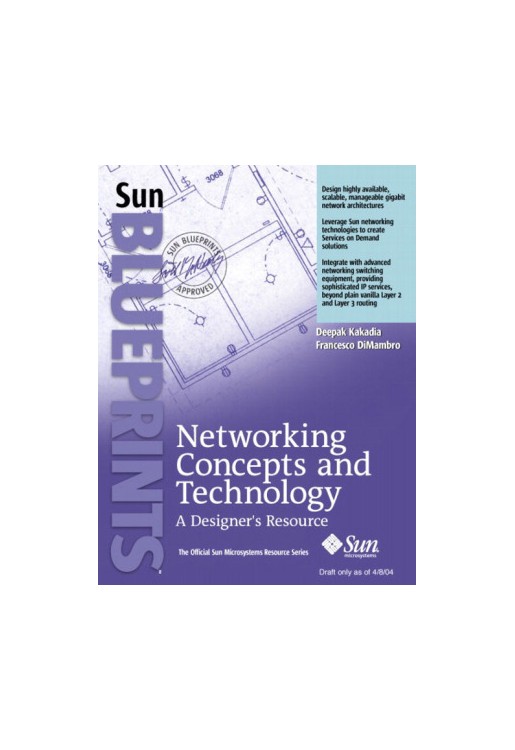Sun ONE solutions, and other services, depend tremendously on optimal network infrastructures. However, there is currently very little information available on how to successfully deploy a strategy based on Sun Networking solutions. Networking technologies have evolved and current basic books do not address the needs of customers who want to understand Sun Networking technology offerings and how to integrate them with advanced networking switching equipment. This book covers emerging IP services, giving the reader a thorough reference of concise information on what Sun's services in this arena are, what benefits they provide, how they are implemented, and exactly where you would want to use them. Example services include Quality of Service, Server Load Balancing, SSL, IPSec, and much more. The authors also tackle the design of highly available, scaleable, manageable gigabit network architectures with a focus on the server to switch tier.
Acknowledgments. Preface. 1. Overview.
Evolution of Web Services Infrastructures.
The Data Center IP Network.
Network Traffic Characteristics.
End-to-End Session: Tuning the Transport Layer.
Network Edge Traffic Steering: IP Services.
Server Networking Internals.
Network Availability Design Patterns.
Reference Implementations.
2. Network Traffic Patterns: Application Layer.
Services on Demand Architecture.
Multi-Tier Architecture and Traffic Patterns.
Mapping Tiers to the Network Architecture.
Inter-tier Traffic Flows.
Web Services Tier.
Application Services Tier.
Architecture Examples.
Designing for Vertical Scalability and Performance.
Designing for Security and Vertical Scalability.
Designing for Security and Horizontal Scalability 33Example Solution.
3. Tuning TCP: Transport Layer.
TCP Tuning Domains.
TCP Queueing System Model.
TCP STREAMS Module Tunable Parameters.
TCP State Model.
Connection Setup.
Connection Established.
Connection Shutdown.
TCP Tuning on the Sender Side.
TCP Congestion Control and Flow Control&38212;Sliding Windows.
TCP Tuning for ACK Control.
TCP Example Tuning Scenarios.
TCP and RDMA Future Data Center Transport Protocols.
4. Routers, Switches, and Appliances&38212;IP-Based Services: Network Layer.
Packet Switch Internals.
Emerging Network Services and Appliances.
Server Load Balancing.
Hash.
Round-Robin.
Smallest Queue First /Least Connections.
Finding the Best SLB Algorithm.
How the Proxy Mode Works.
How Direct Server Return Works.
Server Monitoring.
Persistence.
Commercial Server Load Balancing Solutions.
Layer 7 Switching.
Network Address Translation.
Quality of Service.
The Need for QoS.
Classes of Applications.
QoS Components.
Implementation Functions.
Network and Systems Architecture Overview.
Sources of Unpredictable Delay 99QoS-Capable Devices.
Implementation Approaches.
Functional Components&38212;High-Level Overview.
QoS Profile.
Deployment of Data and Control Planes.
Secure Sockets Layer.
SSL Protocol Overview.
SSL Acceleration Deployment Considerations.
SSL Performance Tests.
Conclusions Drawn from the Tests.
5. Server Network Interface Cards: Datalink and Physical Layer.
Token Ring Networks.
Token Ring Interfaces.
Configuring the SunTRI/S Adapter with TCP/IP.
Disabling Source Routing.
Configuring the SunTRI/P Adapter with TCP/IP.
Configuring the Locally Administered Address.
Fiber Distributed Data Interface Networks.
FDDI Stations.
FDDI Concentrators.
FDDI Interfaces.
Configuring the SunFDDI/S Adapter with TCP/IP.
Configuring the SunFDDI/P Adapter with TCP/IP.
Target Token Rotation Time.
Ethernet Technology.
Software Device Driver Layer.
Ethernet Physical Layer.
Basic Mode Status Register.
Gigabit Media Independent Interface.
Fast Ethernet Interfaces.
10/100 hme Fast Ethernet.
10/100 qfe Quad Fast Ethernet.
10/100 eri Fast Ethernet.
10/100 dmfe Fast Ethernet.
Fiber Gigabit Ethernet.
1000 vge Gigabit Ethernet.
1000 ge Gigabit Ethernet.
10/100/1000 ce GigaSwift Gigabit Ethernet.
10/100/1000 bge Broadcom BCM 5704 Gigabit Ethernet.
Sun VLAN Technology.
VLAN Configuration.
Sun Trunking Technology.
Trunking Configuration.
Network Configuration.
Configuring the System to Use the Embedded MAC Address.
Configuring the Network Host Files.
Setting Up a GigaSwift Ethernet Network on a Diskless Client System.
Installing the Solaris Operating System Over a Network.
Configuring Driver Parameters.
Setting Network Driver Parameters Using the ndd Utility.
Using the ndd Utility in Non-interactive Mode.
Using the ndd Utility in Interactive Mode.
Reboot Persistence Using driver.conf.
Using /etc/system to Tune Parameters.
Network Interface Card General Statistics.
Ethernet Media Independent Interface Kernel Statistics.
Maximizing the Performance of an Ethernet NIC Interface.
Ethernet Physical Layer Troubleshooting.
Deviation from General Ethernet MII/GMII Conventions.
Ethernet Performance Troubleshooting.
6. Network Availability Design Strategies.
Network Architecture and Availability.
Layer 2 Strategies.
Trunking Approach to Availability.
Availability Strategies Using SMLT and DMLT.
Availability Using Spanning Tree Protocol.
Layer 3 Strategies.
VRRP Router Redundancy.
IPMP&38212;Host Network Interface Redundancy.
Integrated VRRP and IPMP.
OSPF Network Redundancy&38212;Rapid Convergence.
RIP Network Redundancy.
Conclusions Drawn from Evaluating Fault Detection and Recovery Times.
7. Reference Design Implementations.
Logical Network Architecture.
IP Services.
Design Considerations: Availability.
Collapsed Layer 2/Layer 3 Network Design.
How Data Flows Through the Service Modules.
Physical Network Implementations.
Secure Multi-Tier.
Multi-Level Architecture Using Many Small Switches.
Flat Architecture Using Collapsed Large Chassis Switches.
Physical Network&38212;Connectivity 320Switch Configuration.
Configuring the Extreme Networks Switches.
Configuring the Foundry Networks Switches.
Network Security.
Netscreen Firewall.
A. Lyapunov Analysis. Glossary. Index. 

